PAW PRINTS
The Voice of Fellow Earthlings' Wildlife Center
April 2010
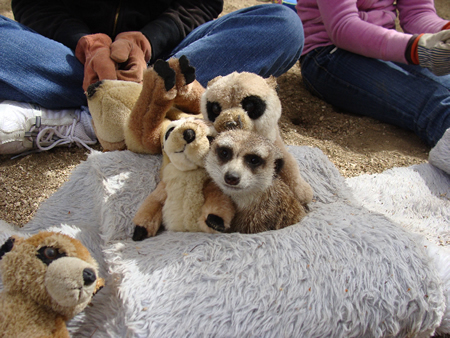
"Beware of Identity Theft!" - Cheeky Rafiki blends into the crowd
Photo Credit: Julie Blew
Springtime greetings to our loyal extended family and honorary “mob” members! All of us here at Fellow Earthlings’ Wildlife Center are reveling in the return of spring, one of our very favorite seasons! The meerkats, coming out of their “winter mode,” are spending lazy days lolling on their backs, soaking up the nurturing sunshine, while we humans scurry about performing all the necessary chores to keep our little Center “humming” along.
We are actually experiencing a positive aspect of the very difficult economic situation, which is a renewed sense of being extremely grateful for the little things. As busy as we are, there seems to be a lovely “slowed” sense of time, with more opportunity to notice the “small stuff.” The return of the migratory hummingbirds, the flurry of nest building as male finches sing out their territorial song to the world, the beautiful red racer snake, freshly emerged from hibernation with his newly shed skin glistening in the sunshine.
We have heard many of the same sentiments from you – our adoptive parents - that although times are tough, there has been a welcome return to simplicity, and a greater appreciation for what we have. A mixed blessing indeed, but hard times bring out the best, in meerkats and humans alike. We know that many of you are struggling, as we are, to keep the bills paid and “bugs” on your own tables – so we are eternally grateful for the re-adoptions that continue to come in, and the donations many of you have been so gracious to give. Every dollar counts towards keeping our “wee rascals” healthy and thriving, and on behalf of the meerkats, we want to say a big THANK YOU for helping us keep the Center afloat. We have faith that these very difficult times will soon pass, and are looking forward to more prosperous days ahead. In the meantime, the meerkats continue to teach us the valuable and precious lessons we try to embrace every day – to live in the moment, cherish and care for those you love, and to “seize” every opportunity to share, learn and of course, play!
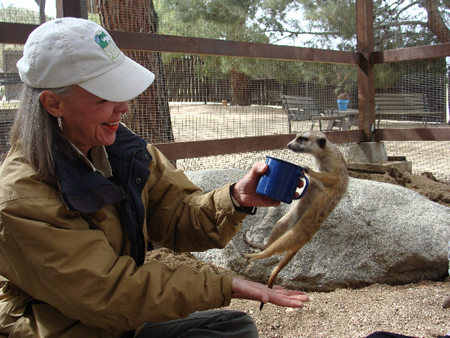
Nalo "bellies" up to the bug mug bar to the amusement of Pam Bennett-Wallberg, director
Photo Credit: Julie Blew
Denise Robertson, Assistant Director, journeys to Africa on a “Meerkat Mission”
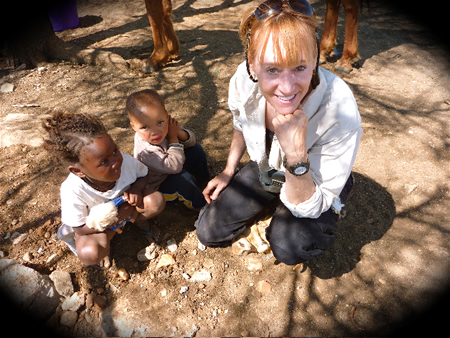
Denise Robertson in the Kalahari with curious Bushman children and a "napping" little meerkat at her feet
Photo Credit: Unknown bushman villager
After diligently working for 20 months on the 2008 Beijing Olympic Games, I was enjoying a well deserved respite, but soon found myself “biting at the bit” to journey once again to the continent I so love – Africa! Even after eight previous trips for durations of six weeks to one year, the “Africa muse” continued to sing in my ear and I could not ignore her inviting call.
This time around, I had a definitive mission – to plunge myself deep into the heart of habitat conservation and wildlife rehabilitation efforts in southern Africa – two topics I am passionate about. I spent two months in South Africa, taking wildlife guiding and tracking courses for my personal education, followed by three months of participating in research projects in South Africa and Namibia with cheetah, leopard and, of course, meerkats! In particular, I was keenly interested in an organization I had heard about in South Africa that had established a successful program of rehabilitating former pet meerkats and releasing them into the wild for a viable chance at a life living free.
The organization, located outside Johannesburg, is a non-profit, non-governmental, wildlife rehabilitation and release center founded in 1997. Holding an open rehabilitation permit from the Nature Conservation Department of South Africa for the rehabilitation and care of mammals, reptiles, and birds, the Center takes in injured, orphaned and abandoned wildlife of all species. At any given time, you might find animals ranging from a Cape Clawless Otter, Honey Badger, or Cape Fox, to jackals, bushbabies, tortoises, and birds of all species – including majestic eagles, stoic owls, chatty hoopoes and brilliant Red-faced Mousebirds. And, of course, meerkats! The sole goal of this wonderful center is to heal, rehabilitate, and release as many of these animals as possible back into the wild.
I contacted Nicci, the Center’s director and senior animal manger, to inquire about the facility, and get information on the wonderful work they do with meerkats. Nicci has been an integral part and the “hands on” driving force of the rehabilitation center since 1998, becoming the senior animal manager in 2000. As a child living in Zambia, Nicci acquired her wildlife rehabilitation skills from her mother, who lovingly took in countless numbers of injured and orphaned animals, caring for them until they could be released once again into their native habitat. Nicci watched, listened, and learned, and has continued the legacy by lending her diverse wildlife skills to this South African rehabilitation center. Nicci, very kindly, responded to my queries, and arrangements were made for me to visit the facility while I was in southern Africa. I arrived in November, at the tail end of my five-month sojourn. My goal was to volunteer, with the hope of humbly lending my modest skills in whatever way I could to assist them, while garnering valuable knowledge about their meerkat rehabilitation and release program. Nicci and the entire team warmly embraced me and I immediately got to work! The first day, I found myself in the clinic making the rounds of feeding countless baby birds by hand. It was spring in South Africa (in the southern hemisphere the seasons are reversed) and due to unusually heavy rains and winds, hatchlings had been blown from nests and, in some cases, entire nests with baby birds just hours old were brought in by caring people who had found them and hoped the Center could save their tiny lives.
I took part in the daily rounds of hand feeding and hydrating countless little birds, many of which had to be tended to every 30 minutes! I observed the loving and careful ministrations of Nicci and her volunteer staff as they resolutely moved from cage to cage, feeding the demanding and boisterous occupants. Boxes and boxes of injured birds and other animals arrived daily, but nothing seemed to ruffle Nicci as she calmly went from one patient to another, diagnosing, writing up charts, and determining whether the injured creature before her could be saved. A delicate Lesser Bushbaby found by the side of the road, a Harrier Hawk shot for “sport,” a baby meerkat confiscated from a roadside stall – the phone never stopped ringing and the animals never stopped coming. I was humbled beyond measure to be a part of this incredible team, albeit for a very short time. The Center is doing amazing work and the dedication and commitment of everyone was nothing short of inspiring.
Not so long ago, no one believed that hand-raised meerkats could be released into the wild to live normal lives. But, Nicci was not one to buy into assumptions, and she was determined to do everything in her power to get the former pet meerkats in her care back where they belonged.
We at Fellow Earthlings’, along with this South African rehabilitation Center and many other organizations, are vehemently against the exotic pet trade and advocate strongly against it. Although meerkats are illegal to own in many countries, there are some where the practice of breeding, selling, and private ownership goes on. Wild animals are meant to be just that – wild – and meerkats, in particular, suffer terribly when they are hand raised as “pets.” The very nature of their genetic makeup is one of being part of a mob or family and, in the absence of their own species, upon sexual maturity (at about twelve months of age) the confused and frustrated animal begins defending the only territory they have – the home they have been confined to by their captors. This territory defense is inevitably exhibited by biting everyone that comes into it, including other human family members in the household. Thus, the once adorable little meerkat quickly becomes a terror and the human family are the victims of the aggression. This either results in the meerkat being confined to a small cage for the rest of its life, or worse, the “owner” will ignorantly take the meerkat to a rural area and simply let it go where it cannot possibly survive alone. If they care enough, they find a rehabilitation center. The Center outside Johannesburg is often the recipient of these meerkats.
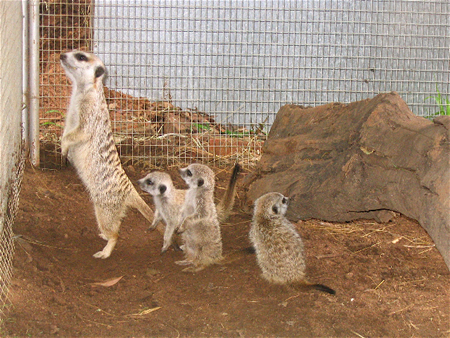
A former pet meerkat, who gave birth at the Centre, patiently waits with her offspring to be integrated into a group for the next scheduled release
Photo Credit: N. Wright
When I arrived the Center had 16 meerkats in several groups awaiting release. Just days later, two more arrived. The protocol for new arrivals is to attempt to introduce them into an existing mob at the Center as quickly as possible, which alone is a monumental task. In the wild, meerkat mobs are almost all blood related – being the offspring of the alpha female and male who are normally the only ones to reproduce. Thus, strangers are rarely accepted. At the Center, since captivity is such a contrived environment and many of the meerkats are not related, these introductions many times do work. Nicci is quite masterful at this challenging task – however, not even her magical touch always ensures cohesiveness, and as such, the Center had several fragmented groups of 3’s and 4’s. Once they have been assessed as to their physical and mental health, the rule is “hands off” – for two reasons. The first is that they are almost always biters at this stage, the second is that it is important to “wild them up” by not having much direct human contact, thus allowing them to depend upon their fellow mob members and prepare them for release. The groups are housed in spacious outdoor enclosures with each group in sight of the others. They are fed twice daily, with occasional live insect sprinkles to keep their foraging instincts strong.
Unfortunately, I was not able to stay for the pending release, which took place in early January. However, I was kept informed by Nicci, along with Joan and Peter (the amazingly committed couple who handle the releases). This tenacious “twosome” has dedicated themselves to helping former pet meerkats back into their native habitat by essentially living in the wild with the meerkats until they are fully prepared to make it on their own.
I was fascinated by this concept and wanted to learn about the techniques they used to gently introduce the meerkats back into the wild. Joan, who has successfully completed the last four meerkat releases, kindly shared her notes with me, which I devoured zealously. Nicci, Joan, and Peter all shared their photos from previous releases which gave me insight into how these complicated missions were accomplished. Knowing how vitally interested all of you are in the well being of our little “fellow earthlings,” I would like to share, in words and pictures, a glimpse into this amazing process:
The first task is to capture the little scurries from their enclosures at the Center! Remembering that these meerkats have become biters as a result of being hand raised, this is a delicate (and sometimes painful!) task. If a “base of the tail” grab, hoist and placement into the crate doesn’t work, a big net comes in very handy! When everyone has been crated, they are loaded into the back of her “bakkie” (that’s a truck in South Africa) – with food to sustain the meerkats during their transition from being captive meerkats to wild and free. (You will be happy to know that the meerkats at Fellow Earthlings do not bite.)

Nicci rounds up the "beasties" for their imminent journey to freedom...
Photo Credit: M. Brocklehurst
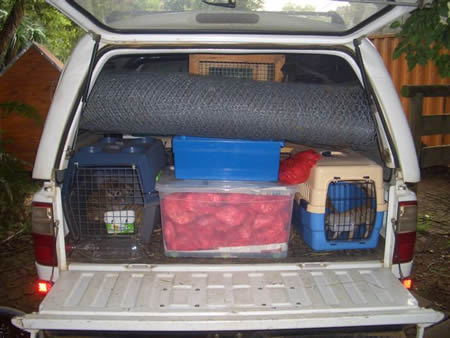
Meerkats, food and fencing all safely loaded and ready to go!
Photo Credit: N. Wright
The timing and step by step procedures are critical. While Nicci is enroute with the meerkats, an advance team is already at the release site, including Joan and her husband Peter, who direct the construction of the “soft release” temporary enclosures which will provide the meerkats with protection while they get accustomed to their new surroundings.
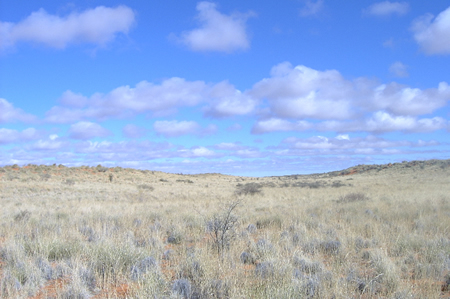
Picture perfect meerkat country! The release site
Photo Credit: Bentley
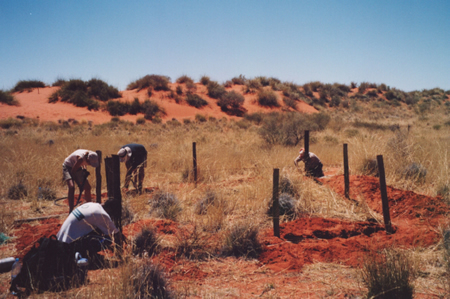
While the meerkats are enroute, the temporary enclosures are erected
Photo Credit: N. Wright
Upon arrival, the meerkat crates are gently unloaded and the animals are finally released into their designated temporary enclosures. Then, they take their first tentative steps in the wild.
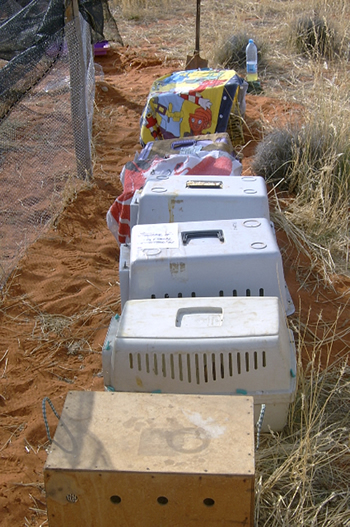
They're Here!!
Photo Credit: N. Wright
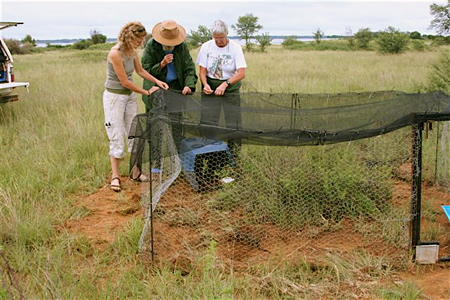
Nicci, Peter, and Joan release the first group of crated meerkats
Photo Credit: R. Turner
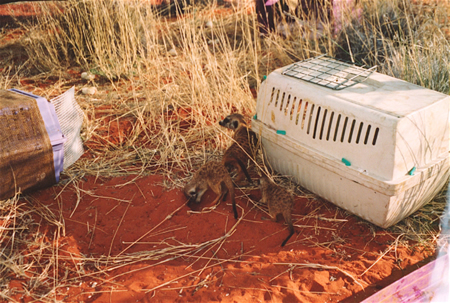
First meerkat steps in the wild!
Photo Credit: N. Wright
The release team must establish a self-sufficient encampment because the process can take anywhere from 10 days to three weeks. Once the enclosures are up and the meerkats tucked away, most of the team departs. Joan and Peter are then left on their own to “mind the meerkats” until they are sure the groups are ready to take on life in the wild. Because they don’t want the meerkats getting used to seeing them or hearing the bakkie and associate the vehicle with food, the camp is set up a distance away which enables the meerkat groups to gain confidence on their own while they gradually disassociate from humans.
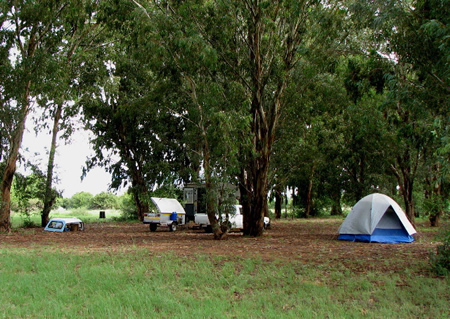
Joan and Peter's camp headquarters, located a good distance away from the enclosures
Photo Credit: P. Gossett
Joan and Peter start the release process by simply allowing the meerkats to begin creating their own burrows inside the temporary enclosures. The team strategically puts the wire enclosures in areas that provide good substrate for digging or where there are already vacant burrows that have been dug by other creatures which gives them a “head start.” The crates are also left inside the enclosures initially – a sort of security blanket. And, of course, water is provided.
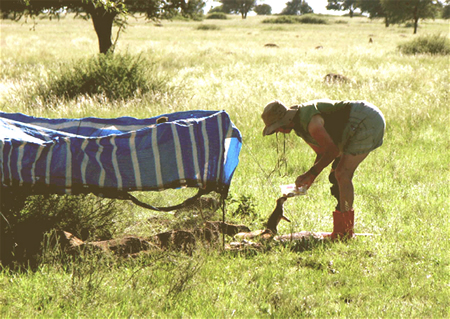
Joan gives a "helping hand" (full of mealworms!) to a newly released meerkat
Photo Credit: P. Gossett
They are fed twice a day and, after a time, the door of the enclosure is left ajar while Joan and Peter are present. This initiates little “walkabouts” with the meerkats venturing out for the first time, foraging, and discovering all the joys of being free, but still having the security of their “human sentries” nearby.
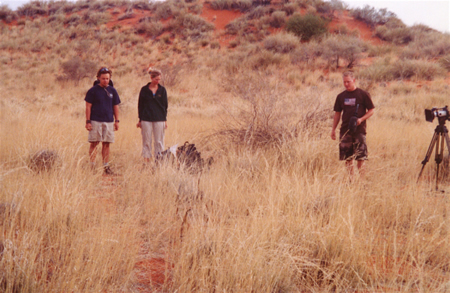
First "Walkabout" - can you make out the meerkat tails in the high grass?
Photo Credit: V. Law
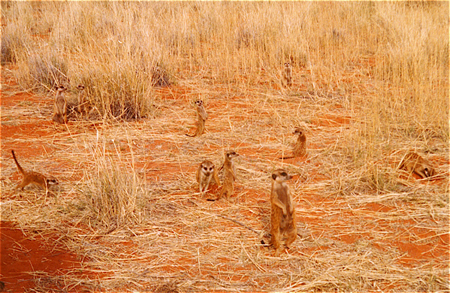
First group foraging excursion
Photo Credit: N. Wright
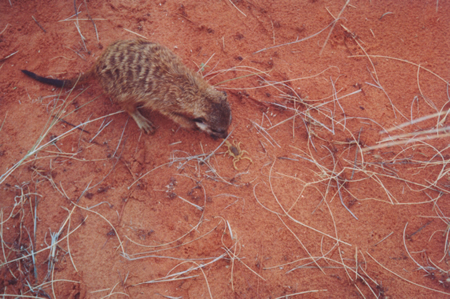
"Handle with Care!" a meerkat tackles a freshly caught scorpion
Photo Credit: N. Wright
The meerkats retreat to the temporary enclosures for the night and are locked in for the first days to ensure they will all be safe. When Joan and Peter deem they are ready, the enclosure door is closed only with a pile of dirt against it – to give the humans enough time to run to the hidden vehicle and drive away before the meerkats can dig themselves out (“Hey, the food is leaving!”) The next days find the meerkats truly free, albeit they still have the safety of their enclosures to return to, and are unknowingly being observed from afar (with a very good pair of binoculars!) by Joan and Peter, who continue to monitor their progress while surreptitiously “sneaking” in additional food to subsidize their foraging while the groups are away from the burrows.
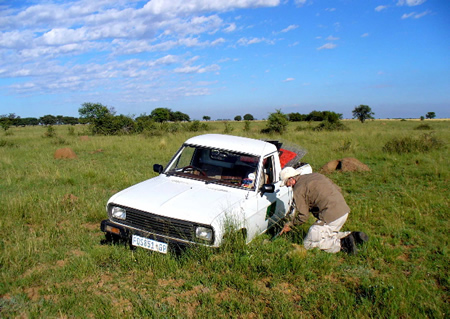
Getting around isn't always easy! Peter "digs" out after the bakkie bogs down in the rain soaked earth
Photo Credit: J. Gossett
The releases are always done seasonally, when there have been good rains resulting in bountiful insects for the picking – good for meerkats, challenging for vehicles! Additionally, the sites are carefully chosen near a water source, as although wild meerkats normally get all their moisture from their food, being raised in captivity means these meerkats are more dependent upon water.
As to the fragmented groups, Nicci, Joan and Peter have discovered that even though there may be multiple groups released near one another which were not bonded at the Center, they often end up “banding” together upon release – knowing there is safety in numbers – which gives them a much higher rate of survival in the wild. The more members, the more eyes to watch the sky and ground for predators. Perhaps the most frustrating part of the release process for Joan and Peter is the confusing “sorting” out of the various mobs – the mixing and matching of members that takes place among them once they are all fully free. It was interesting to read Joan’s previous reports with notes such as “Minders are now with the Beesknees group and two of the Tripod meerkats have migrated into Madams group along with Mom and the babies.”
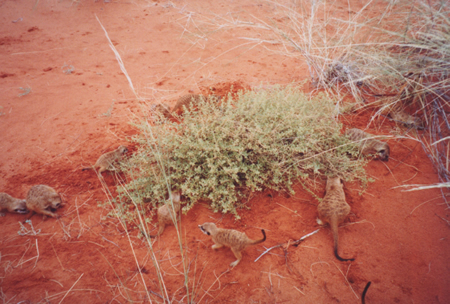
So many bugs, so little time...
Photo Credit: N. Wright
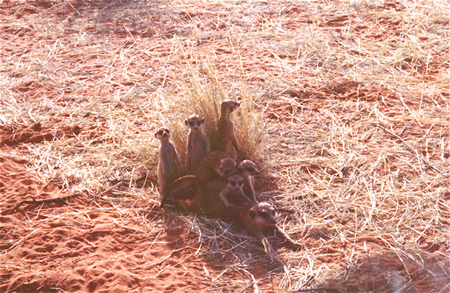
Digger and her offspring enjoy the freedom of a Kalahari afternoon sprawled on the sand
Photo Credit: N. Wright
So how do Joan and Peter know when it is time to leave the meerkats to their own devices? Upon questioning her, Joan told me it is always quite apparent when the humans have worn out their welcome. It seems the meerkats begin to chase the couple (and occasionally bite!) when they come back to check on their welfare. In essence, the meerkats are saying “this is our territory now – go away!” which clearly signals it is time for Joan and Peter to bid them a fond farewell, pack up their gear, and come home to a well-deserved hot shower and soft bed.
I am happy to report that the January release of 25 meerkats was successful! The ranger in the reserve where the release took place has reported seeing the meerkats in the veldt foraging, so they seem to have adjusted quite well.
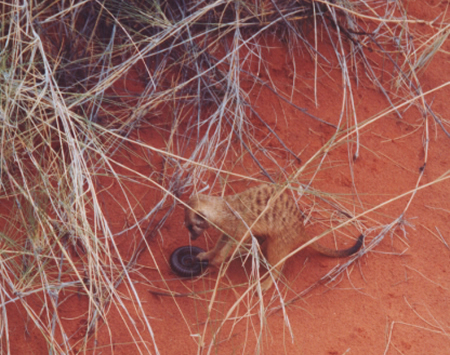
A shongololo (giant millipede) is a delectable find!
Photo Credit: N. Wright
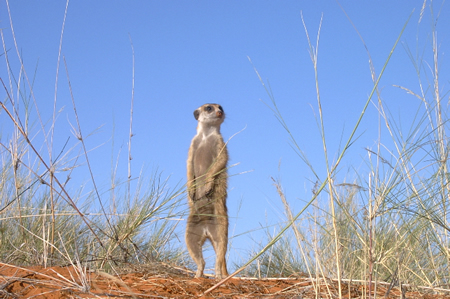
A dedicated mob member takes on one of the first sentry duties...
Photo Credit: Bentley
It is gratifying to know these intelligent, sensitive, and gregarious creatures have been given the gift of a life living free – all due to the dedication of Nicci, Joan, Peter, and the other team members. Experts said it couldn’t be done, but this wonderful Center with its innovation and dedication has proven otherwise. And, although individual meerkats are lost sometimes, it is heartwarming to know that these endearing animals are given the opportunity to live full lives in the wild and not in a cage.
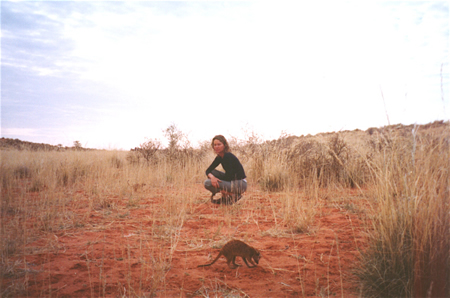
Nicci says her final goodbye to little "Twiggy" before heading home with a happy heart
Photo Credit: Bentley
The campaign to educate people about the cruelty of keeping meerkats as pets continues. South Africa stopped issuing permits for meerkats in 2003, but the illegal trade goes on. Unscrupulous pet dealers rob burrows of pups and sell them by the side of the road and illegal breeders keep captive pairs of meerkats in suburban backyards. Females are kept perpetually pregnant, churning out litter after litter, with pups being pulled and sold at 3 weeks of age to create a forced dependant bond with the buyer. The rehabilitation center in South Africa, Fellow Earthlings’, and others are working to stop this horrific trade in meerkats and other innocent species. Sadly, we often receive emails from people located in the UK and other places in Europe where meerkats are still legal to buy and sell. We try to be diplomatic and, at the same time, educate these misdirected people about the cruelty of keeping meerkats as pets in apartments and in cages. Meerkats as pets essentially translates to sentencing them to solitary confinement. Captivity is a terrible thing for any wild animal but, for a gregarious creature like a meerkat, which depends upon the mob for everything, it is psychological torture. Many cases have come to light where the deeply distressed animals begin inflicting injury upon themselves by obsessively chewing on their paws or tail.
My hat is off to the committed team at the wildlife center for the tireless work they are doing not only for meerkats, but also for all sentient beings who are in need of a helping hand. For those that have no voice, this caring facility is the bright and beckoning light at the end of a sometimes very dark tunnel.
My deep gratitude goes to Nicci, Joan, and Peter for embracing me into their world and renewing my faith that somehow, someday, humans will finally extend the dignity and respect to the furred and feathered, pawed and clawed, that they so richly deserve. Just imagine what a kinder, gentler world that will be!
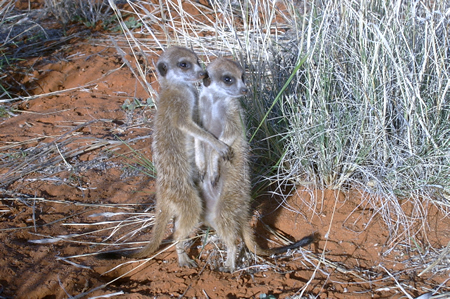
Photo Credit: Bentley
Because the heart beats under a covering of hair, of fur, feathers, or wings, it is, for that reason, to be of no account?
Jean Paul Richter
Postscript
Some of you may be wondering why we don’t fly our meerkats to South Africa to be released into the wild. Pam and I discussed the viability of this at length, many years ago. Since our meerkats come to us due to medical problems, old age, and other issues, we quickly realized the chances of our meerkats, who are already at a disadvantage, to survive in the wild, would be very slim to none. Our conclusion was that it would in fact be more cruel than kind to inflict this upon them during their advanced years. Thus, we continue our mission to provide a life long home and the most enriching life possible for the zoo born meerkats that are placed with us.
Epilogue
My journey to Africa was at once the best and the hardest trip to that beloved continent I have ever experienced. I ran the gauntlet of emotions – from unadulterated joy, to the depths of despair and anguish. Joy was my most welcome companion – it flooded my being as I gazed out upon the pristine desert landscapes of Namibia, experienced impossibly beautiful sunsets that made me feel at one with the whole universe, and witnessed the courage and tenacity of the diverse wildlife that forges on, despite humankind’s continual efforts to control and thwart it’s very existence at every turn. Despair and anguish was just as frequent a visitor. Immense sadness filled me at witnessing captive animals torn from the wild and being sold as exotic pets, despair at the knowledge of secret compounds on wildlife reserves where lions were bred and raised to be shot by “trophy hunters” in the canned hunting industry, and anger at seeing fences everywhere I looked – fences that kept wildlife out, fences that kept wildlife in, fences that prevented wildlife from using their centuries old traditional migration routes, which in turn has upset the entire delicate balance that nature so carefully designed and we humans have so carelessly violated.
But the light and hope came in the form of the people I met along the way. Without question they took me in, this nomadic stranger who arrived unannounced on their doorsteps. With trust and open arms, they allowed me to ask endless questions, and gave me the freedom to explore, experience, and work with them side by side to get my answers. Gracious, kind, strong men and women, fighting the good fight for the wildlife of the world – sacrificing comfort, money, and material wealth to give back to the planet and simply do what they think is right. I was humbled beyond measure, and I took heart at the thought that if each and every one of us answered this critical call to action on behalf of wildlife, and in some small way, did just one thing to benefit the animals that share our world, it just couldn’t help but change everything. I’ve seen it and experienced it first hand, through the determination and perseverance of these wildlife warriors, and I will never be the same again.
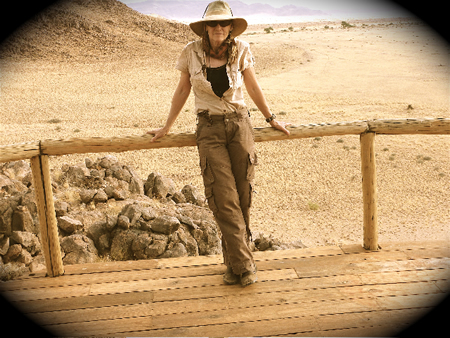
Photo Credit: Self Timer
